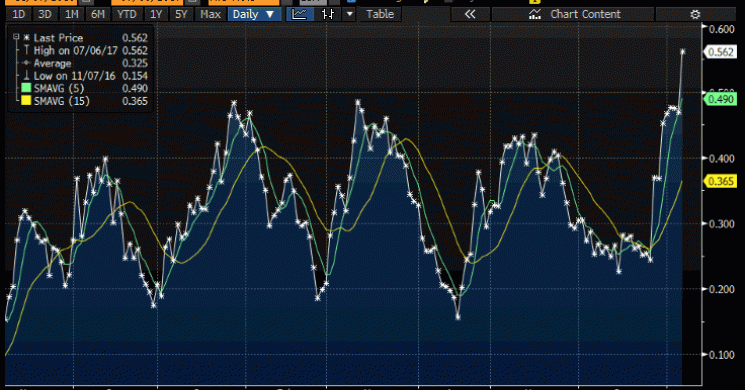
Recap July 6th
Simultaneous selling pressure in equities and U.S. Treasurys made this session an unpleasant one for practitioners of risk parity. A late extension to the downside pushed the S&P 500 through the low end of its tight recent trading range to its lowest close since May 24th.
Bear-steepening in the Treasury curve pushed the spread between five and 30 year yields wider off the more than eight year lows reached yesterday.
Yield of dreams
Interest rate risk still exists, after all. Sovereign yields have spiked in Europe of late, with regional economic champion Germany seeing its 10-year yield jumping nearly 10 basis points today to 0.562%, its highest since January of 2016. Just last week the same paper was priced to yield 0.24%. With a coupon of 0.25% on the current 10-year note, the recent downtick in face value from north of 100 to just above 97 cents on the Euro represents a loss equivalent nearly 12 years of coupon payments (more than the life of the bond).
No margin of safety here. German 10 year yield:

Neighboring France has seen yields on its 10-year note move to 0.92% from sub 0.60% last Monday, while BBB-plus rated Spain has seen its 10-year yield rise to 1.68% from 1.37% in that same period.
The selloff is all the more remarkable as the European Central Bank is in the midst of a €60 billion-per-month QE program. Amidst self-imposed mechanical restrictions such as the “capital key” rule dictating that sovereign bond purchases be proportional to the size of the country issuing them, as well as its limit of 33% ownership in any particular bond issue, the ECB is finding itself increasingly constrained on what it can buy, according to Kim Liu of ABN Amro:
The recent data reveals that the ECB is forced to de facto taper its core-country buys even before the QE program’s potential deadline of December 2017…the constraints are becoming more visible and will intensity.
However, upward pressure on sovereign borrowing rates has not been confined to Europe. The even more central bank-dominated-Japanese bond market has also sold off, its benchmark 10-year yield reaching a near five month high of 0.104% from 0.047% last Tuesday. Bloomberg reminds us that “after the yield jumped to 0.15% on Feb. 3, the (Bank of Japan) held a fixed-rate operation to buy an unlimited amount of the securities to bring yields back down.”
Virtually zero-yielding 10-year debt is a BoJ policy in service of its policy goal of measured 2% inflation. The demonstrated efficacy of low rates in this regard has been wanting: Over the past 20 years, the 10-year Japanese Government Bond yield has averaged 1.176%. During that time, Japanese annualized CPI has registered above 2% in only 21 months, or under 9% of the time. One hundred twenty-six monthly readings in that period has CPI been in contraction year-on-year, more than 52% of the time. Perhaps one day the widely held presupposition that zero or negative nominal interest rates necessarily stimulate consumer inflation will come under closer inspection.
Up the credit risk-river, emerging market sovereign bonds have also seen their yields lurch higher, all but closing a valuation gap with emerging market corporate debt. Bloomberg today reports that the yield spread between the USD Emerging Markets Sovereign Index and the corporate index has dropped to just four basis points, the lowest level on record. As recently as January of 2016, the yield gap between those two indices was as wide as 168 basis points.
The selloff in government bond yields of all stripes has not spared the Argentine Republic, a nation that has defaulted eight times in its history but recently returned to investors’ good graces following the 2015 election of Mauricio Macri as president. Argentina has since fully availed itself of the now-accommodative capital markets, raising more than $10 billion in USD-denominated debt so far in 2017, well beyond the $7 billion on dollar bonds that the government planned to issue this year as of January.
If not a direct catalyst for the reversal, the mid-June sale of 100-year Argentinian bonds (Almost Daily Grant’s, June 19) at a yield to worst of 7.917% roughly coincided with the interim highs in sovereign debt prices. Issued at 90 cents on the dollar, the century bonds initially rallied to as high as 93 before reversing. Today they traded to their lowest level in their brief existence, dropping below 89 cents on the dollar on an intraday basis.
On the bright side, investors only have to wait 99 years, 11 months and two weeks until principal repayment. Time flies when you’re having fun.
CLICK HERE to begin a six-issue Trial Subscription to GRANT'S. Offer ends July 15, 2017.
Say’s who?
Department of Energy secretary Rick Perry, at a West Virginia coal plant earlier today, as quoted by Taylor Kuykendall of S&P:
"Here’s a little economics lesson: supply and demand. You put the supply out there and the demand will follow."
- Philip Grant
Read more by Soren K.Group







